Megalimidae – Asian Barbets
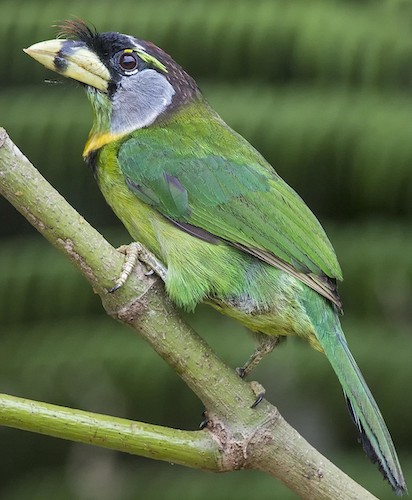
The Megalaimidae are a Piciformes family of birds comprising the Asian barbets. They were once lumped in with all barbets in the family Capitonidae, but the Old-World species have been found to be distinctive and are considered, along with the Lybiidae (African Barbets), Capitonidae (New World Barbets), Semnornithidae (Toucan Barbets), Ramphastidae (Toucans), Indicatoridae (Honeyguides) and Picidae (Woodpeckers) as sister groups. There are currently 35 species recognised, living in the forests of the Indo-Malayan region from Tibet to Indonesia. Their diversity is concentrated around the Malay Peninsula and Sumatra; it is therefore probable that the family originated there or thereabouts.
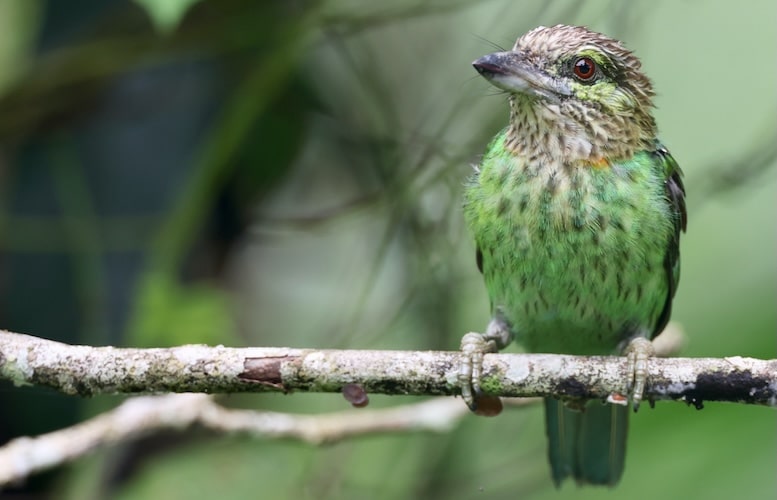
Green-eared Barbet Psilopogon faiostrictus – ©Bird-Photo-Tours ASIA
They are usually plump-looking, with large heads, and heavy bills fringed with bristles. The Great Barbet, at 210g and 33cm is the largest of the species, and among its relatives is only surpassed in size by some of the toucans.
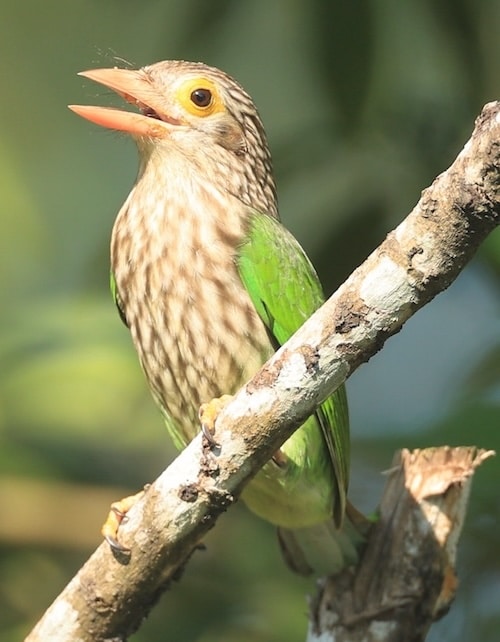
Lineated Barbet Psilopogon lineatus – ©Bird-Photo-Tours ASIA
Asian barbets are usually birds of the inner forest. One species, the Coppersmith Barbet, has adapted to life on the forest edge and in scrub. They are mainly solitary birds, eating insects and fruit. Figs of the genus Ficus are the most important fruit taken. Large fig trees will attract several species of barbet along with other frugivores. In addition to figs, numerous other species of fruiting tree and bush are visited; an individual barbet may feed on as many as 60 different species in its range. They will also visit plantations and take cultivated fruit and vegetables. Fruit is eaten whole and indigestible material such as seed pits regurgitated later (often before singing). Unlikr toucans, regurgitation does not usually happen in the nest. Barbets are thought to be important agents in seed dispersal in tropical forests.
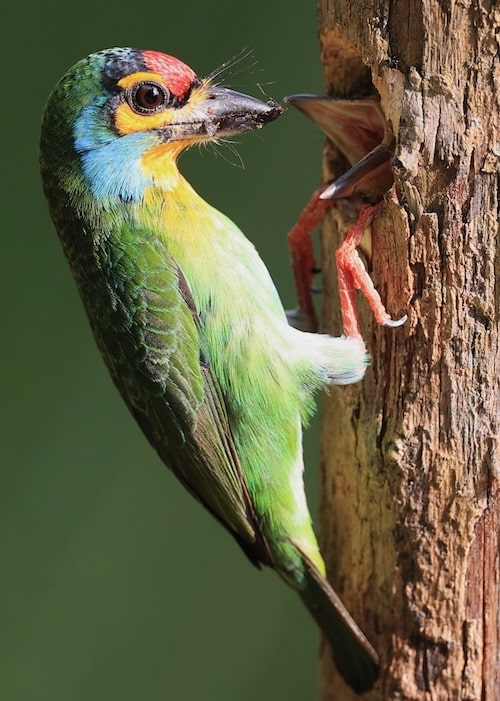
Crimson-fronted Barbet Psilopogon rubricapillus – ©Bird-Photo-Tours ASIA
As well as taking fruit, barbets also take arthropod prey, gleaned from the branches and trunks of trees. A wide range on insects are taken, including ants, cicadas, dragonflies, crickets, locusts, beetles, moths and mantids. Scorpions and centipedes are also taken, and a few species will take small vertebrates such as lizards, frogs and geckos.
The precise nesting details of many species are not yet known. Like many members of the order Piciformes, their nests are in holes bored into a tree, and they usually lay between 2 and 4 eggs, incubated for 13 to 15 days.
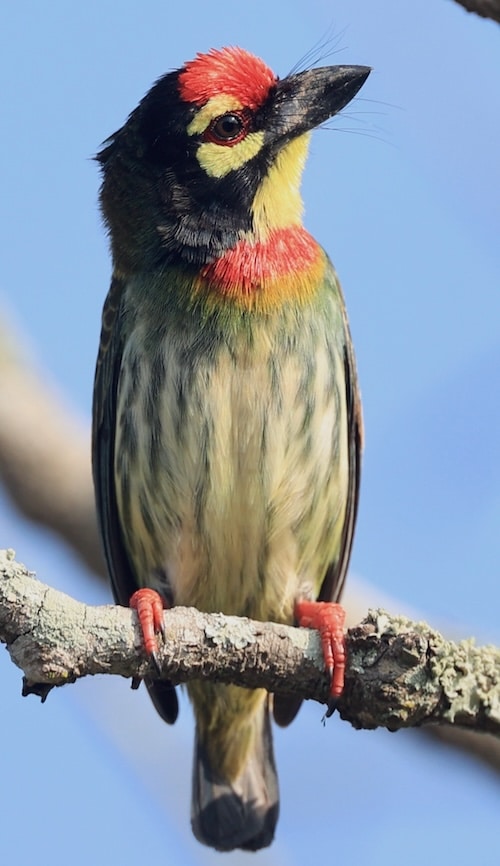
Coppersmith Barbet Psilopogon haemacephalus – ©Bird-Photo-Tours ASIA
There is generally not much interaction between Asian barbets and humans. Some species, such as the Great Barbet and the Lineated Barbet, will raid plantations and orchards, particularly in India, and there is some capture for the cage-bird trade due to their attractive coloration. Some species will frequent parks and large gardens.
Although none of the Asian barbets are considered threatened, several species are known to be intolerant of deforestation and require old-growth forest to thrive. For example, in Singapore only the second-growth-tolerant Red-crowned Barbet remains of the species originally found there, as well as the Coppersmith Barbet which has expanded its range and colonised Singapore in the 1960s.
-
Number of bird species: 35
(As at July 2025)
According to the IOC and others undertaking DNA and morphological research, there are 35 species of Asian Barbets in the Megalimidae family, which are:
Sooty Barbet Caloramphus hayii
Brown Barbet Caloramphus fuliginosus
Malabar Barbet Psilopogon malabaricus
Crimson-fronted Barbet Psilopogon rubricapillus
Coppersmith Barbet Psilopogon haemacephalus
Blue-eared Barbet Psilopogon cyanotis
Black-eared Barbet Psilopogon duvaucelii
Yellow-eared Barbet Psilopogon australis
Bornean Barbet Psilopogon eximius
Fire-tufted Barbet Psilopogon pyrolophus
Great Barbet Psilopogon virens
Red-vented Barbet Psilopogon lagrandieri
Red-crowned Barbet Psilopogon rafflesii
Red-throated Barbet Psilopogon mystacophanos
Black-banded Barbet Psilopogon javensis
Golden-naped Barbet Psilopogon pulcherrimus
Yellow-crowned Barbet Psilopogon henricii
Flame-fronted Barbet Psilopogon armillaris
Green-eared Barbet Psilopogon faiostrictus
Lineated Barbet Psilopogon lineatus
Brown-headed Barbet Psilopogon zeylanicus
White-cheeked Barbet Psilopogon viridis
Yellow-fronted Barbet Psilopogon flavifrons
Golden-throated Barbet Psilopogon franklinii
Necklaced Barbet Psilopogon auricularis
Mountain Barbet Psilopogon monticola
Brown-throated Barbet Psilopogon corvinus
Golden-whiskered Barbet Psilopogon chrysopogon
Moustached Barbet Psilopogon incognitus
Chinese Barbet Psilopogon faber
Taiwan Barbet Psilopogon nuchalis
Blue-throated Barbet Psilopogon asiaticus
Indochinese Barbet Psilopogon annamensis
Black-browed Barbet Psilopogon oorti
Turquoise-throated Barbet Psilopogon chersonesus
-
Biology of Indian Barbets
| By HSA Yahya | Authors Press | 2001 | Hardback | 170 pages, Figs, tabs | ISBN: 9788172730604 Buy this book from NHBS.com -
Toucans, Barbets and Honeyguides
| By Lester L Short, Jennifer FM Horne & Albert Earl Gilbert | Oxford University Press | 2001 | Hardback | 526 pages, 36 colour plates, colour photos, illustrations, maps | ISBN: 9780198546665 Buy this book from NHBS.com
-
Asian Barbets
WebpageA family of birds comprising the Asian barbets, the Megalaimidae were once united with all other barbets in the Capitonidae (Short and Horne 2002). Still, they have turned out to be distinct. There are 26 species living in wooded areas from Tibet to Indonesia... -
Megalimidae
WebpageAsian Barbets
-
Black-banded Barbet Psilopogon javensis
Species AccountLarge barbet with an immense chisel-like bill. Leaf-green overall, with a red throat, black mask, and bright yellow crown and round spot at the base of the bill... -
Black-banded Barbet Psilopogon javensis
Species AccountThe black-banded barbet (Psilopogon javensis) is a bird species in the Megalaimidae family. It is endemic to Java and Bali. -
Black-banded Barbet Psilopogon javensis
Species AccountSong, distribution etc -
Black-browed Barbet Psilopogon oorti
Species AccountLoud but sluggish and difficult-to-see canopy inhabitant of highland forests in peninsular Malaysia and Sumatra. -
Black-browed Barbet Psilopogon oorti
Species AccountThe black-browed barbet (Psilopogon oorti) is an Asian barbet native to Peninsular Malaysia and Sumatra, where it inhabits foremost forests between 600 and 2,000 m (2,000 and 6,600 ft) altitude. -
Black-browed Barbet Psilopogon oorti
Species AccountSong, distribution etc -
Black-eared Barbet Psilopogon duvaucelii
Species AccountThe black-eared barbet is a barbet in the family Megalaimidae native to Peninsular Malaysia, Sumatra and Borneo. -
Black-eared Barbet Psilopogon duvaucelii
Species AccountThis species has an extremely large range, and hence does not approach the thresholds for Vulnerable under the range size criterion... -
Black-eared Barbet Psilopogon duvaucelii
Species AccountA small barbet of dense, broad-leaved forests in lowland and foothill regions. -
Blue-eared Barbet Psilopogon cyanotis
Species AccountA small barbet of dense, broad-leaved forests in lowland and foothill regions. -
Blue-eared Barbet Psilopogon cyanotis
Species AccountThe blue-eared barbet (Psilopogon cyanotis) is a barbet in the Megalaimidae family native to mainland Southeast Asia. Because of its wide distribution and stable population it is listed as Least Concern on the IUCN Red List. -
Blue-eared Barbet Psilopogon cyanotis
Species AccountSong, distribution etc -
Blue-throated Barbet Psilopogon asiaticus
Species AccountSound archive and distribution map. -
Blue-throated Barbet Psilopogon asiaticus
Species AccountThe blue-throated barbet (Psilopogon asiaticus) is an Asian barbet having bright green, blue & red plumage, seen across the Indian subcontinent and Southeast Asia. Barbets and toucans are a group of near passerine birds with a worldwide tropical distribution. The barbets get their name from the bristles which fringe their heavy bills; this species eats fruits and insects. They frequent evergreen forests, deciduous forests, gardens, orchards, teak forests and cities with fruiting trees. The turquoise-throated barbet was formerly considered a subspecies. -
Bornean Barbet Psilopogon eximius
Species AccountSmall, stout barbet of Borneo’s wet foothill and montane forest. -
Bornean Barbet Psilopogon eximius
Species AccountIt is found in Indonesia and Malaysia where it is endemic to the island of Borneo. -
Bornean Barbet Psilopogon eximius
Species AccountSong, distribution etc -
Bornean Brown Barbet Caloramphus fuliginosus
IUCN Species StatusBornean Brown Barbet Caloramphus fuliginosus has most recently been assessed for The IUCN Red List of Threatened Species in 2016. Caloramphus fuliginosus is listed as Least Concern. -
Brown Barbet Caloramphus fuliginosus
Species AccountThe brown barbet (Caloramphus fuliginosus) is a species of bird in the family Megalaimidae. It is found in Brunei, Kalimantan (Indonesia), Sabah (Malaysia). Its natural habitat is subtropical or tropical moist lowland forests. -
Brown Barbet Caloramphus fuliginosus
Species AccountSound archive and distribution map. -
Brown-headed Barbet Psilopogon zeylanicus
Species AccountThe brown-headed barbet or large green barbet (Psilopogon zeylanicus) is an Asian barbet. Barbets and toucans are a group of near passerine birds with a worldwide tropical distribution. The barbets get their name from the bristles which fringe their heavy bills. -
Brown-headed Barbet Psilopogon zeylanicus
IUCN Species StatusBrown-headed Barbet Psilopogon zeylanicus has most recently been assessed for The IUCN Red List of Threatened Species in 2016. Psilopogon zeylanicus is listed as Least Concern. -
Brown-headed Barbet Psilopogon zeylanicus
Species AccountSound archive and distribution map. -
Brown-throated Barbet Psilopogon corvinus
Species AccountSong, distribution etc -
Brown-throated Barbet Psilopogon corvinus
Species AccountUnique large barbet of western Java. Leaf-green with a dark bill and an earth-brown head. Restricted to montane and foothill forests (800-2000 meters). -
Brown-throated Barbet Psilopogon corvinus
Species AccountThe brown-throated barbet (Psilopogon corvinus) is a species of bird in the family Megalaimidae. It is endemic to western Java. -
Chinese Barbet Psilopogon faber
Species AccountA brightly-colored inhabitant of tropical forest canopies. Slow moving and well camouflaged; its loud and far-carrying song, combined with its secrecy, ensure that it is usually heard far more often than seen... -
Chinese Barbet Psilopogon faber
Species AccountThe Chinese barbet (Psilopogon faber) is a bird in the family Megalaimidae. The species was first described by Robert Swinhoe in 1870. It is endemic to southern China. -
Chinese Barbet Psilopogon faber
Species AccountSong, distribution etc -
Coppersmith Barbet Psilopogon haemacephalus
Species AccountThe coppersmith barbet, crimson-breasted barbet or coppersmith (Psilopogon haemacephalus), is a bird with crimson forehead and throat which is best known for its metronomic call that has been likened to a coppersmith striking metal with a hammer. It is a resident found in the Indian subcontinent and parts of Southeast Asia. Like other barbets, they chisel out a hole inside a tree to build their nest. They are mainly fruit eating but will take sometimes insects, especially winged termites. -
Coppersmith Barbet Psilopogon haemacephalus
IUCN Species StatusCoppersmith Barbet Psilopogon haemacephalus has most recently been assessed for The IUCN Red List of Threatened Species in 2016. Psilopogon haemacephalus is listed as Least Concern. -
Coppersmith Barbet Psilopogon haemacephalus
Species AccountSound archive and distribution map. -
Crimson-fronted Barbet Psilopogon rubricapillus
Species AccountThe crimson-fronted barbet or Ceylon small barbet or small barbet (Psilopogon rubricapillus) is an Asian barbet endemic to Sri Lanka. The Malabar barbet endemic to the Western Ghats of India used to be treated as a subspecies of this species.[2] Barbets and toucans are a group of near passerine birds with a worldwide tropical distribution. The barbets get their name from the bristles which fringe their heavy bills. -
Crimson-fronted Barbet Psilopogon rubricapillus
Species AccountSound archive and distribution map. -
Fire-tufted Barbet Psilopogon pyrolophus
Species AccountSong, distribution etc -
Fire-tufted Barbet Psilopogon pyrolophus
Species AccountThe fire-tufted barbet (Psilopogon pyrolophus) is a species of bird in the Asian barbet family Megalaimidae. -
Fire-tufted Barbet Psilopogon pyrolophus
Species AccountBeautiful emerald-green barbet. Note silvery cheeks, white forehead, and black chinstrap; namesake reddish tuft above the base of the bill is small and often difficult to see from a distance. -
Flame-fronted Barbet Psilopogon armillaris
Species AccountThe flame-fronted barbet (Psilopogon armillaris) is an Asian barbet native to Java and Bali. It has a green plumage, a yellow-orange forehead, a blue nape... -
Golden-naped Barbet Psilopogon pulcherrimus
Species AccountThe highest-ranging of Borneo's endemic barbets, found in montane forest from 1000 m up to 3000 m or more. -
Golden-naped Barbet Psilopogon pulcherrimus
Species AccountThe golden-naped barbet (Psilopogon pulcherrimus) is a member of the family Megalaimidae. It is found in Indonesia and Malaysia, where it is endemic... -
Golden-naped Barbet Psilopogon pulcherrimus
Species AccountSong, distribution etc -
Golden-throated Barbet Psilopogon franklinii
Species AccountThis species has an extremely large range... -
Golden-throated Barbet Psilopogon franklinii
Species AccountLarge green barbet with a broad black bandit’s mask, a pale gray face, and a black-and-yellow crown... -
Golden-throated Barbet Psilopogon franklinii
Species AccountSong, distribution etc -
Golden-whiskered Barbet Psilopogon chrysopogon
Species AccountBright yellow cheek stands out like a sunburst on the muddy-looking face of this barbet. Traces of red and blue also brighten the head of this heavy-billed green bird. Inhabits lowland and foothill forests. -
Golden-whiskered Barbet Psilopogon chrysopogon
Species AccountThe golden-whiskered barbet (Psilopogon chrysopogon) is an Asian barbet species native to the western Malay Archipelago, where it inhabits foremost forests up to 1,500 m (4,900 ft) elevation. -
Golden-whiskered Barbet Psilopogon chrysopogon
Species AccountSong, distribution etc -
Great Barbet Psilopogon virens
IUCN Species StatusGreat Barbet Psilopogon virens has most recently been assessed for The IUCN Red List of Threatened Species in 2018. Psilopogon virens is listed as Least Concern. -
Great Barbet Psilopogon virens
Species AccountThe great barbet (Psilopogon virens) is an Asian barbet. Barbets are a group of near passerine birds with a worldwide tropical distribution. They get their name from the bristles which fringe their heavy bills. -
Green-eared Barbet Psilopogon faiostrictus
Species AccountSound archive and distribution map. -
Green-eared Barbet Psilopogon faiostrictus
Species AccountThe green-eared barbet (Psilopogon faiostrictus) is an Asian barbet. Barbets are a group of near passerine birds with a worldwide tropical distribution. They get their name from the bristles which fringe their heavy bills. -
Indochinese Barbet Psilopogon annamensis
Species AccountLoud but sluggish and difficult-to-see canopy inhabitant of the Annamite highlands in western Vietnam, eastern Laos, and far eastern Cambodia. Green with an electric-blue face, pale yellow crown and throat, and thick black eyebrows. -
Indochinese Barbet Psilopogon annamensis
Species AccountThe Indochinese barbet (Psilopogon annamensis), also called Annam barbet, is a bird belonging to the family Megalaimidae. -
Indochinese Barbet Psilopogon annamensis
Species AccountSong, distribution etc -
Lineated Barbet Psilopogon lineatus
Species AccountThe lineated barbet (Psilopogon lineatus) is a large barbet found in the northern parts of the Indian subcontinent, along the southern foothills of the Himalayas and also in parts of Bangladesh and West Bengal. Like other barbets it is a frugivore. In nests inside holes bored into tree trunks. -
Lineated Barbet Psilopogon lineatus
IUCN Species StatusLineated Barbet Psilopogon lineatus has most recently been assessed for The IUCN Red List of Threatened Species in 2016. Psilopogon lineatus is listed as Least Concern. -
Lineated Barbet Psilopogon lineatus
Species AccountSound archive and distribution map. -
Malabar Barbet Psilopogon malabaricus
Species AccountThe Malabar barbet (Psilopogon malabaricus) is a small barbet found in the Western Ghats of India. It was formerly treated as a race of the crimson-fronted barbet (Psilopogon rubricapillus). It overlaps in some places with the range of the coppersmith barbet (Psilopogon haemacephala) and has a similar but more rapid call. -
Malabar Barbet Psilopogon malabaricus
Species AccountSound archive and distribution map. -
Malay Barbet aka Sooty Barbet Caloramphus hayii
IUCN Species StatusMalay Brown Barbet Caloramphus hayii has most recently been assessed for The IUCN Red List of Threatened Species in 2021. Caloramphus hayii is listed as Near Threatened under criteria A2c+3c+4c. -
Mountain Barbet Psilopogon monticola
Species AccountSong, distribution etc -
Mountain Barbet Psilopogon monticola
Species AccountFaded-looking barbet of Borneo’s north-central mountain ranges. Grass-green above and pale green below, with a pale blue head, an off-white throat, and a bright red streak on the back of the head. -
Mountain Barbet Psilopogon monticola
Species AccountThe mountain barbet (Psilopogon monticola) is a species of bird in the family Megalaimidae. It is endemic to the Southeast Asian -
Moustached Barbet Psilopogon incognitus
Species AccountTypical barbet, green with a brightly-colored face. Facial pattern is plainer than some barbets’, but subtly attractive nonetheless: blue overall with red speckles on the edges and black lines through the eye and across the cheek. -
Moustached Barbet Psilopogon incognitus
Species AccountThe moustached barbet (Psilopogon incognitus) is an Asian barbet. Barbets are a group of near passerine birds with a world-wide tropical distribution. They get their name from the bristles which fringe their heavy bills. -
Moustached Barbet Psilopogon incognitus
Species AccountSong, distribution etc -
Necklaced Barbet Psilopogon auricularis
Species AccountBrightly-colored barbet restricted to the Annamite Range of southern Vietnam and southeastern Laos, where it inhabits hill and montane forests. -
Necklaced Barbet Psilopogon auricularis
Species AccountThe necklaced barbet (Psilopogon auricularis) is an Asian barbet species occurring in Laos and southern Vietnam, where it inhabits subtropical, lowland... -
Necklaced Barbet Psilopogon auricularis
Species AccountSong, distribution etc -
Psilopogon armillaris
Species AccountMedium-sized foothill-dweller, generally limited to forests and woodlands between 600 and 2500 meters. Endemic to Java, where its combination of a bright yellow-orange forehead, powder-blue hindcrown, and orange “bowtie” is unique -
Psilopogon armillaris
Species AccountSong, distribution etc -
Red-crowned Barbet Psilopogon rafflesii
Species AccountSong, distribution etc -
Red-crowned Barbet Psilopogon rafflesii
Species AccountThe red-crowned barbet (Psilopogon rafflesii) is part of one of the two subfamilies of Megalaimidae birds -
Red-crowned Barbet Psilopogon rafflesii
Species AccountBrightly colored barbet with a massive, heavy dark bill. Green with an intricate black-yellow-red-blue facial pattern. -
Red-throated Barbet Psilopogon mystacophanos
Species AccountThis forest-dependent species is thought to be declining moderately rapidly as a result of continuing habitat loss throughout its range. It is therefore considered Near Threatened. -
Red-throated Barbet Psilopogon mystacophanos
Species AccountLarge emerald-green barbet with a heavy dark bill. Unlike many barbets, exhibits strong sexual dimorphism: male has yellow, black, blue, and red facial patches, while the female only has blue and red. -
Red-throated Barbet Psilopogon mystacophanos
Species AccountThe red-throated barbet (Psilopogon mystacophanos) is a species of bird in the family Megalaimidae. It is found in Brunei, Indonesia, Malaysia, Myanma... -
Red-vented Barbet Psilopogon lagrandieri
Species AccountThe brown-and-gray head of this barbet sets it apart from the bright facial patterns of most other species. Specks of blue, red, and yellow on the face are visible at close range. -
Red-vented Barbet Psilopogon lagrandieri
Species AccountThe red-vented barbet (Psilopogon lagrandieri) is an Asian barbet native to Laos, Vietnam and Cambodia, where it inhabits subtropical or tropical moist lowland forest and subtropical or tropical moist montane forests. -
Red-vented Barbet Psilopogon lagrandieri
Species AccountSong, distribution etc -
Sooty Barbet Caloramphus hayii
Species AccountThe sooty barbet (Caloramphus hayii) is a species of bird in the family Megalaimidae. It is found in Malaysia, Myanmar, Singapore (extinct), Thailand, and Sumatra (Indonesia). Its natural habitat is subtropical or tropical moist lowland forests -
Sooty Barbet Caloramphus hayii
Species AccountSound archive and distribution map. -
Sri Lankan Barbetaka Crimson-fronted Barbet Psilopogon rubricapillus
IUCN Species StatusSri Lanka Barbet Psilopogon rubricapillus has most recently been assessed for The IUCN Red List of Threatened Species in 2016. Psilopogon rubricapillus is listed as Least Concern. -
Taiwan Barbet Psilopogon nuchalis
Species AccountSong, distribution etc -
Taiwan Barbet Psilopogon nuchalis
Species AccountThe Taiwan barbet (Psilopogon nuchalis), also known as the embroidered barbet, is a species of bird endemic to Taiwan. -
Taiwan Barbet Psilopogon nuchalis
Species AccountHighly distinctive Taiwan endemic, bright green with a rainbow-hued face in red, blue, and yellow. Inhabits forests, parks, and gardens from lowlands into montane regions. -
White-cheeked Barbet Psilopogon viridis
Species AccountThe white-cheeked barbet or small green barbet (Psilopogon viridis) is a species of barbet found in southern India. It is very similar to the more widespread brown-headed barbet (or large green barbet) (Psilopogon zeylanica) but this species has a distinctive supercilium and a broad white cheek stripe below the eye and is endemic to the forest areas of the Western Ghats and adjoining hills. -
White-cheeked Barbet Psilopogon viridis
Species AccountSound archive and distribution map. -
Yellow-crowned Barbet Psilopogon henricii
Species AccountBeautiful, softly colored barbet with a powder-blue throat, a dark “mascara” mask around the eye, and a bright yellow forehead and brow. -
Yellow-crowned Barbet Psilopogon henricii
Species AccountThe yellow-crowned barbet (Psilopogon henricii) is a species of bird in the Megalaimidae family. It is found in Brunei, Indonesia, Malaysia, Singapore... -
Yellow-crowned Barbet Psilopogon henricii
Species AccountSong, distribution etc -
Yellow-eared Barbet Psilopogon australis
Species AccountThe yellow-eared barbet is an Asian barbet native to Java and Bali. It inhabits shrubland and forest up to an altitude of 2,000 m (6,600 ft). -
Yellow-eared Barbet Psilopogon australis
Species AccountSmall leaf-green barbet, endemic to Java and Bali. -
Yellow-eared Barbet Psilopogon australis
Species AccountSong, distribution etc -
Yellow-fronted Barbet Psilopogon flavifrons
Species AccountThe yellow-fronted barbet (Psilopogon flavifrons) is an Asian barbet which is an endemic resident breeder in Sri Lanka. Barbets and toucans are a group of near passerine birds with a worldwide tropical distribution. The barbets get their name from the bristles which fringe their heavy bills. -
Yellow-fronted Barbet Psilopogon flavifrons
Species AccountSound archive and distribution map.
